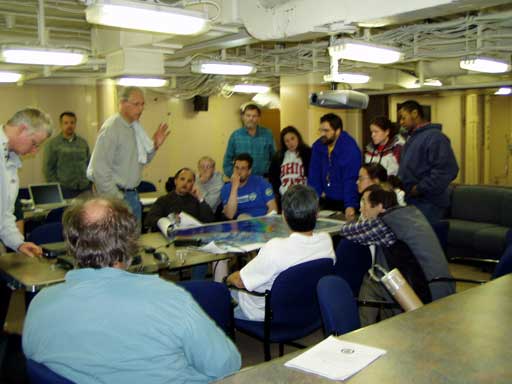( Log In ) Log In is for TREC Teachers & Researchers only
  |
| Steve_Marshall |
 Jun 16 2005, 04:19 AM Jun 16 2005, 04:19 AM
Post
#1
|
 TREC Teacher    Group: TREC Team Posts: 78 Joined: 27-April 05 Member No.: 12 |
Note: Again, if pictures are not present, they will soon be following
6/14/05 #2 Whatís The Plan? Starting Out the Day Today was the first full day on the ship, and it definitely felt like a full day with all that went on. The live connect to the schools at 7:15 and 7:45am was just the beginning of a busy day. It seems like so much is happening that I start losing track of what happened when and on what day. It definitely feels like weíve been on here longer than just since yesterday with all thatís going on. The fact that itís light all the time doesnít help in dividing up one day from the next either. Anyway, this morning was the clearest and brightest it has been yet. The brightness and the reflection off the ice made a picture that I always imagined the Arctic to be like. The temperature was still in the lower to mid 30s F, but the sun actually felt warm against us even though itís at such a low angle up here. Classic Arctic Picture  The low angle of the sun seems to make the ice reflect the light directly to your eyes. Sunglasses are a must, but itís still an awesome sight to see. (Photo: Steve Roberts) Change of Plans One thing that was quickly apparent is that the idea of being flexible was still a major theme. Due to the ice still being relatively thick, it was determined that going to the original coring sites would take too much time. Additionally, the sonar equipment, which helps to determine the best place for coring cannot be used in extremely icy conditions, so there had to be a compromise between getting the cores at the depths desired, and also being able to maximize the sonar, seismic, and other acoustic data that not only helps select the core sites, but is also useful for general mapping data. Ice Is Not Your Friend  To give you an idea of size, this ice on edge is more than five feet thick. This is the type of thing that was slowing down our travels Working Together While this overall discussion about the best place to go and the best plan to meet everyoneís objectives was taking place, other researchers were discussing what they would be doing once we actually got some data or core samples. In listening to the conversations, I quickly began to realize how much planning and coordination must go into a research cruise such as this. It also made me realize that there are an incredible number of different ways a core sample can be sampled that most people would never think of. One researcher would be examining the foraminifera (microscopic, shelled animals) and other life present in the sediment, another would be studying how much water filled the spaces between the sediment grains, others would study the different radioactive elements in the sample to determine itís age, yet another scientists would look at the type of minerals in the core, and the list goes on. Considering the Options  The researchers spent time looking over a map of the area to determine the best locations to sample and the best course to take Since the samples are limited, all the people conducting their various studies would have to determine how to divide up the samples, and discuss how their research would fit in with what other scientists were doing. What was going on here was exactly what I had predicted when relating my experiences at the orientation in April regarding working with different cultures. While different cultures ARE represented here, the mutual respect and working together I mentioned applies more to research interests than cultures. Everyone has to work together as a team, realizing one personís research and interests is just as important as any others, and figure out the best way to meet everyoneís objectives. In listening to this group, I would say they have done an excellent job in obtaining that mutual understanding and respect. Going Over the Details  The lead scientist, Dennis Darby, discusses the plan of action with the science group Sharing the Knowledge and Enthusiasm Not only are the scientists working together, but some are going beyond and volunteering to give me samples so I can get students involved in the process also. They are very excited to share their research and interests, and their desire is to pass that excitement onto students. In fact, we have a few college students here who came with their instructors because the professors have done much to instill their same enthusiasm in their students. After only a couple of days, it has definitely been an exciting and enlightening experience to be a part of this group. Not only that, but I also realize what an honor and a privilege it is to be a part of this group. |
  |
1 User(s) are reading this topic (1 Guests and 0 Anonymous Users)
0 Members:

|
NSF Acknowledgment & Disclaimer | Time is now: 20th November 2024 - 03:27 PM |
Invision Power Board
v2.1.7 © 2024 IPS, Inc.








